VOLVO S40 2010 Owner´s Manual
Manufacturer: VOLVO, Model Year: 2010, Model line: S40, Model: VOLVO S40 2010Pages: 292, PDF Size: 6.75 MB
Page 211 of 292
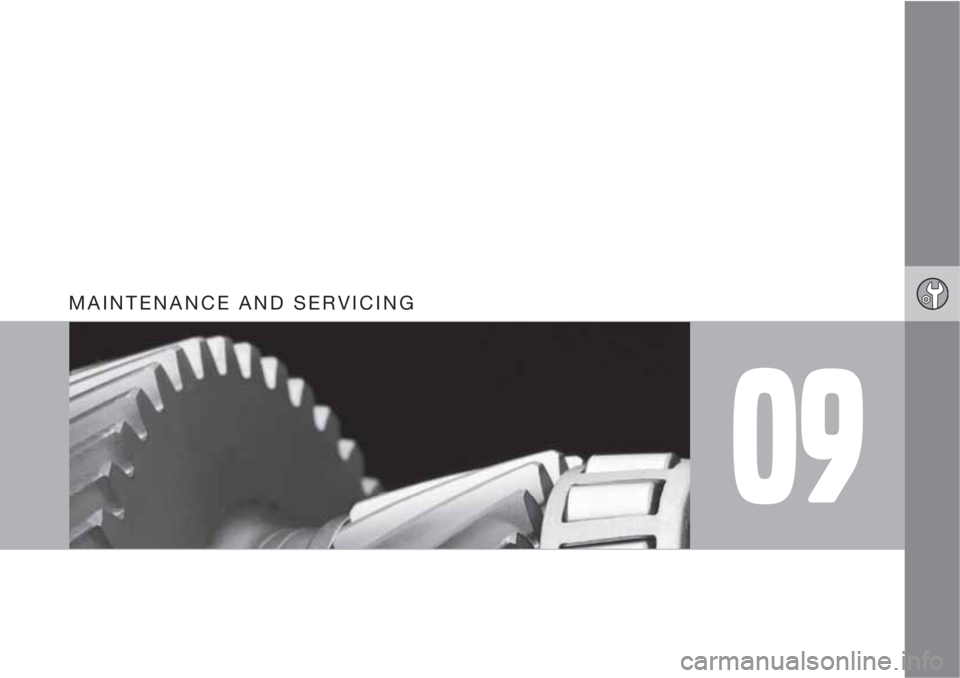
09
MAINTENANCE AND SERVICING
Page 212 of 292
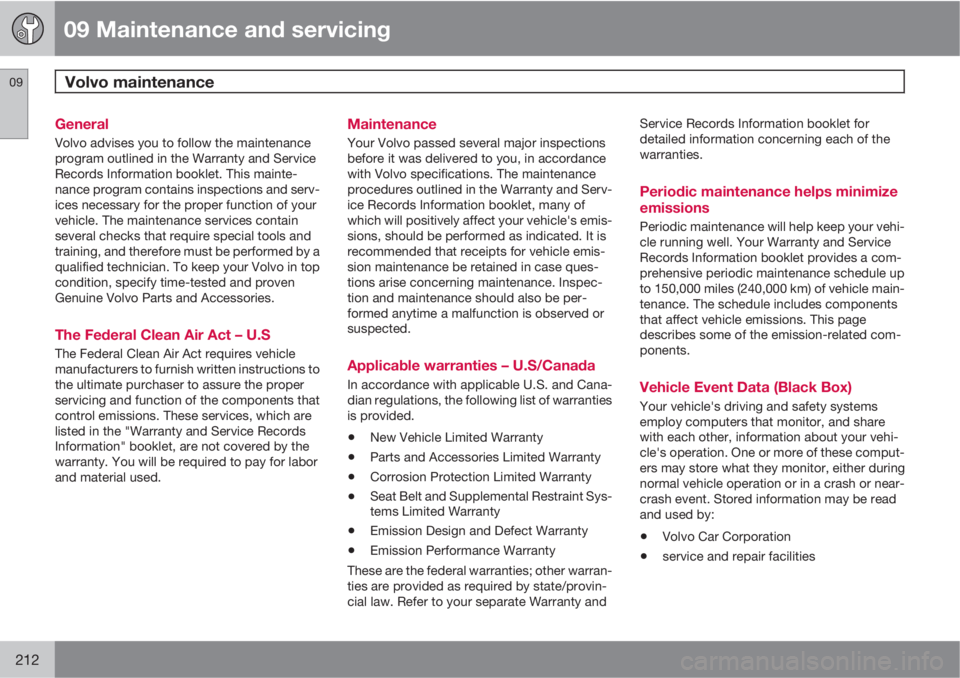
09 Maintenance and servicing
Volvo maintenance 09
212
General
Volvo advises you to follow the maintenance
program outlined in the Warranty and Service
Records Information booklet. This mainte-
nance program contains inspections and serv-
ices necessary for the proper function of your
vehicle. The maintenance services contain
several checks that require special tools and
training, and therefore must be performed by a
qualified technician. To keep your Volvo in top
condition, specify time-tested and proven
Genuine Volvo Parts and Accessories.
The Federal Clean Air Act – U.S
The Federal Clean Air Act requires vehicle
manufacturers to furnish written instructions to
the ultimate purchaser to assure the proper
servicing and function of the components that
control emissions. These services, which are
listed in the "Warranty and Service Records
Information" booklet, are not covered by the
warranty. You will be required to pay for labor
and material used.
Maintenance
Your Volvo passed several major inspections
before it was delivered to you, in accordance
with Volvo specifications. The maintenance
procedures outlined in the Warranty and Serv-
ice Records Information booklet, many of
which will positively affect your vehicle's emis-
sions, should be performed as indicated. It is
recommended that receipts for vehicle emis-
sion maintenance be retained in case ques-
tions arise concerning maintenance. Inspec-
tion and maintenance should also be per-
formed anytime a malfunction is observed or
suspected.
Applicable warranties – U.S/Canada
In accordance with applicable U.S. and Cana-
dian regulations, the following list of warranties
is provided.
•New Vehicle Limited Warranty
•Parts and Accessories Limited Warranty
•Corrosion Protection Limited Warranty
•Seat Belt and Supplemental Restraint Sys-
tems Limited Warranty
•Emission Design and Defect Warranty
•Emission Performance Warranty
These are the federal warranties; other warran-
ties are provided as required by state/provin-
cial law. Refer to your separate Warranty andService Records Information booklet for
detailed information concerning each of the
warranties.
Periodic maintenance helps minimize
emissions
Periodic maintenance will help keep your vehi-
cle running well. Your Warranty and Service
Records Information booklet provides a com-
prehensive periodic maintenance schedule up
to 150,000 miles (240,000 km) of vehicle main-
tenance. The schedule includes components
that affect vehicle emissions. This page
describes some of the emission-related com-
ponents.
Vehicle Event Data (Black Box)
Your vehicle's driving and safety systems
employ computers that monitor, and share
with each other, information about your vehi-
cle's operation. One or more of these comput-
ers may store what they monitor, either during
normal vehicle operation or in a crash or near-
crash event. Stored information may be read
and used by:
•Volvo Car Corporation
•service and repair facilities
Page 213 of 292
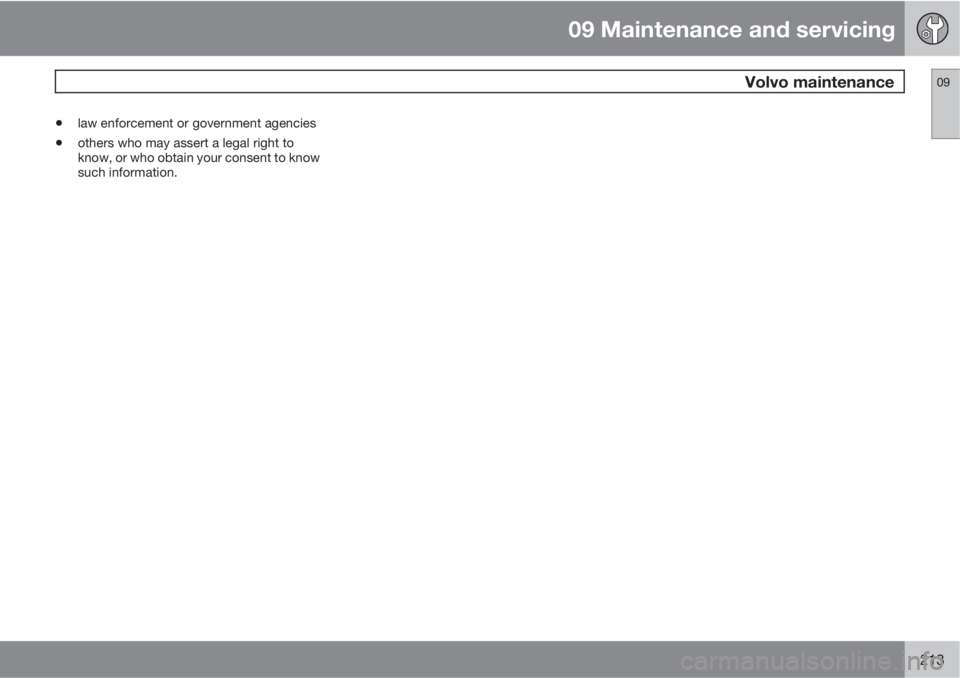
09 Maintenance and servicing
Volvo maintenance09
213
•law enforcement or government agencies
•others who may assert a legal right to
know, or who obtain your consent to know
such information.
Page 214 of 292
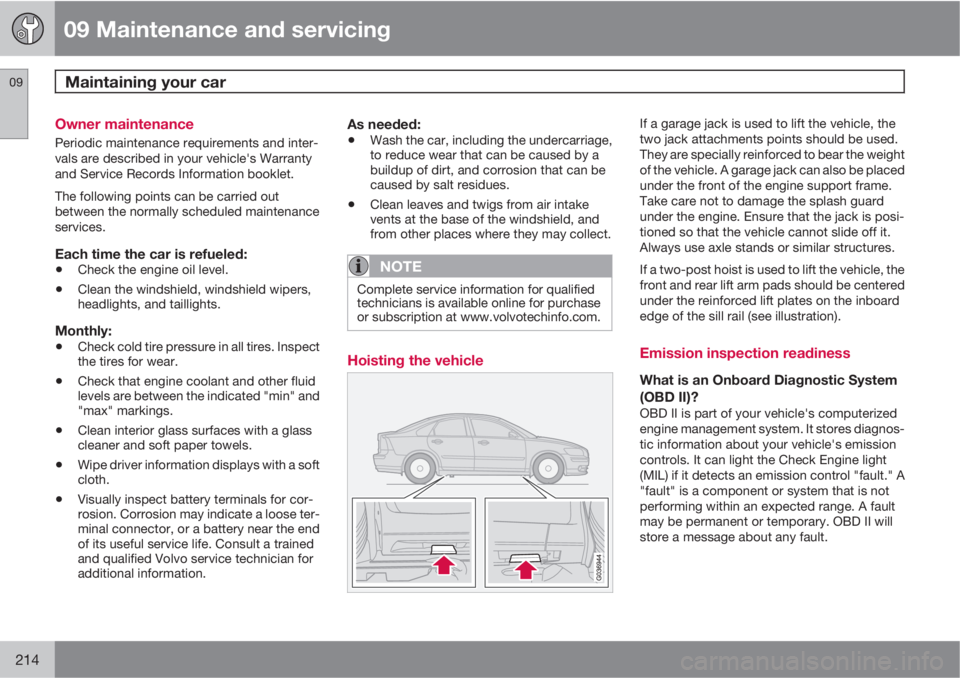
09 Maintenance and servicing
Maintaining your car 09
214
Owner maintenance
Periodic maintenance requirements and inter-
vals are described in your vehicle's Warranty
and Service Records Information booklet.
The following points can be carried out
between the normally scheduled maintenance
services.
Each time the car is refueled:
•Check the engine oil level.
•Clean the windshield, windshield wipers,
headlights, and taillights.
Monthly:
•Check cold tire pressure in all tires. Inspect
the tires for wear.
•Check that engine coolant and other fluid
levels are between the indicated "min" and
"max" markings.
•Clean interior glass surfaces with a glass
cleaner and soft paper towels.
•Wipe driver information displays with a soft
cloth.
•Visually inspect battery terminals for cor-
rosion. Corrosion may indicate a loose ter-
minal connector, or a battery near the end
of its useful service life. Consult a trained
and qualified Volvo service technician for
additional information.
As needed:
•Wash the car, including the undercarriage,
to reduce wear that can be caused by a
buildup of dirt, and corrosion that can be
caused by salt residues.
•Clean leaves and twigs from air intake
vents at the base of the windshield, and
from other places where they may collect.
NOTE
Complete service information for qualified
technicians is available online for purchase
or subscription at www.volvotechinfo.com.
Hoisting the vehicle
If a garage jack is used to lift the vehicle, the
two jack attachments points should be used.
They are specially reinforced to bear the weight
of the vehicle. A garage jack can also be placed
under the front of the engine support frame.
Take care not to damage the splash guard
under the engine. Ensure that the jack is posi-
tioned so that the vehicle cannot slide off it.
Always use axle stands or similar structures.
If a two-post hoist is used to lift the vehicle, the
front and rear lift arm pads should be centered
under the reinforced lift plates on the inboard
edge of the sill rail (see illustration).
Emission inspection readiness
What is an Onboard Diagnostic System
(OBD II)?
OBD II is part of your vehicle's computerized
engine management system. It stores diagnos-
tic information about your vehicle's emission
controls. It can light the Check Engine light
(MIL) if it detects an emission control "fault." A
"fault" is a component or system that is not
performing within an expected range. A fault
may be permanent or temporary. OBD II will
store a message about any fault.
Page 215 of 292
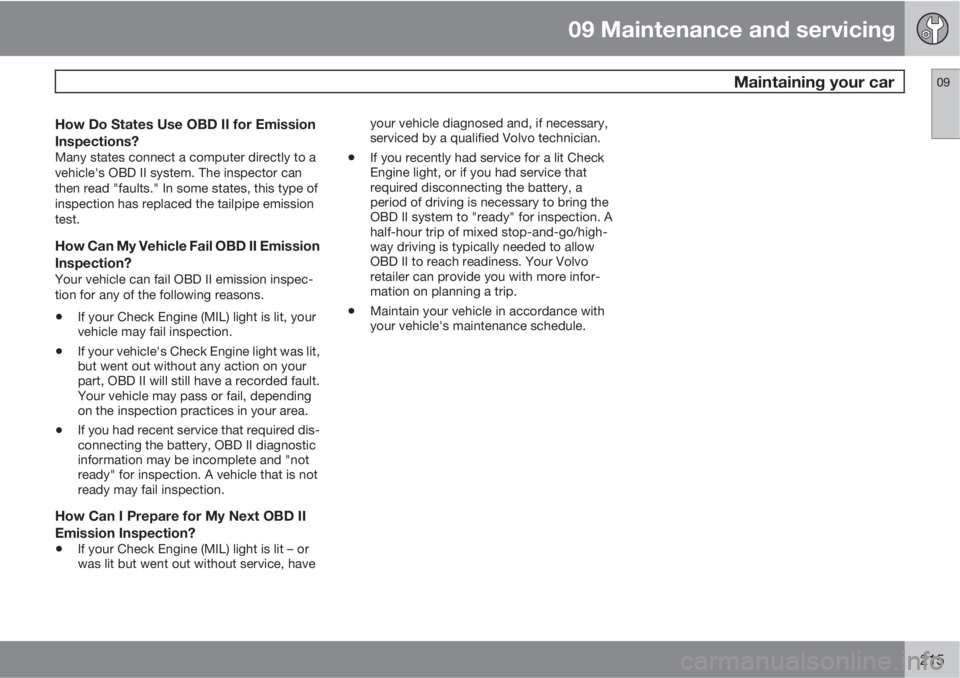
09 Maintenance and servicing
Maintaining your car09
215
How Do States Use OBD II for Emission
Inspections?
Many states connect a computer directly to a
vehicle's OBD II system. The inspector can
then read "faults." In some states, this type of
inspection has replaced the tailpipe emission
test.
How Can My Vehicle Fail OBD II Emission
Inspection?
Your vehicle can fail OBD II emission inspec-
tion for any of the following reasons.
•If your Check Engine (MIL) light is lit, your
vehicle may fail inspection.
•If your vehicle's Check Engine light was lit,
but went out without any action on your
part, OBD II will still have a recorded fault.
Your vehicle may pass or fail, depending
on the inspection practices in your area.
•If you had recent service that required dis-
connecting the battery, OBD II diagnostic
information may be incomplete and "not
ready" for inspection. A vehicle that is not
ready may fail inspection.
How Can I Prepare for My Next OBD II
Emission Inspection?
•If your Check Engine (MIL) light is lit – or
was lit but went out without service, haveyour vehicle diagnosed and, if necessary,
serviced by a qualified Volvo technician.
•If you recently had service for a lit Check
Engine light, or if you had service that
required disconnecting the battery, a
period of driving is necessary to bring the
OBD II system to "ready" for inspection. A
half-hour trip of mixed stop-and-go/high-
way driving is typically needed to allow
OBD II to reach readiness. Your Volvo
retailer can provide you with more infor-
mation on planning a trip.
•Maintain your vehicle in accordance with
your vehicle's maintenance schedule.
Page 216 of 292
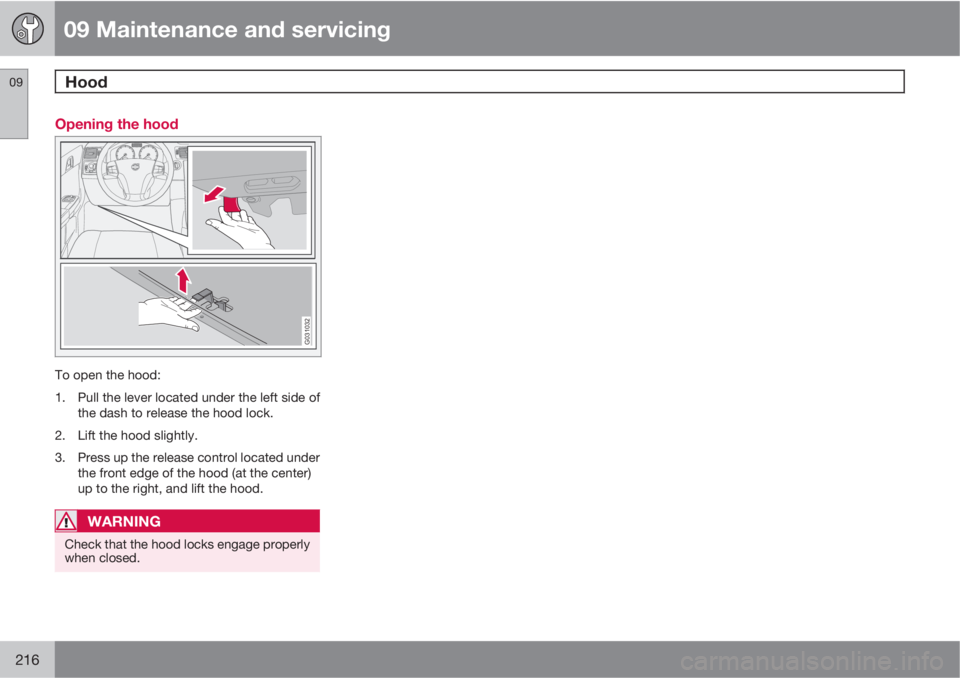
09 Maintenance and servicing
Hood 09
216
Opening the hood
G031032
To open the hood:
1. Pull the lever located under the left side of
the dash to release the hood lock.
2. Lift the hood slightly.
3. Press up the release control located under
the front edge of the hood (at the center)
up to the right, and lift the hood.
WARNING
Check that the hood locks engage properly
when closed.
Page 217 of 292
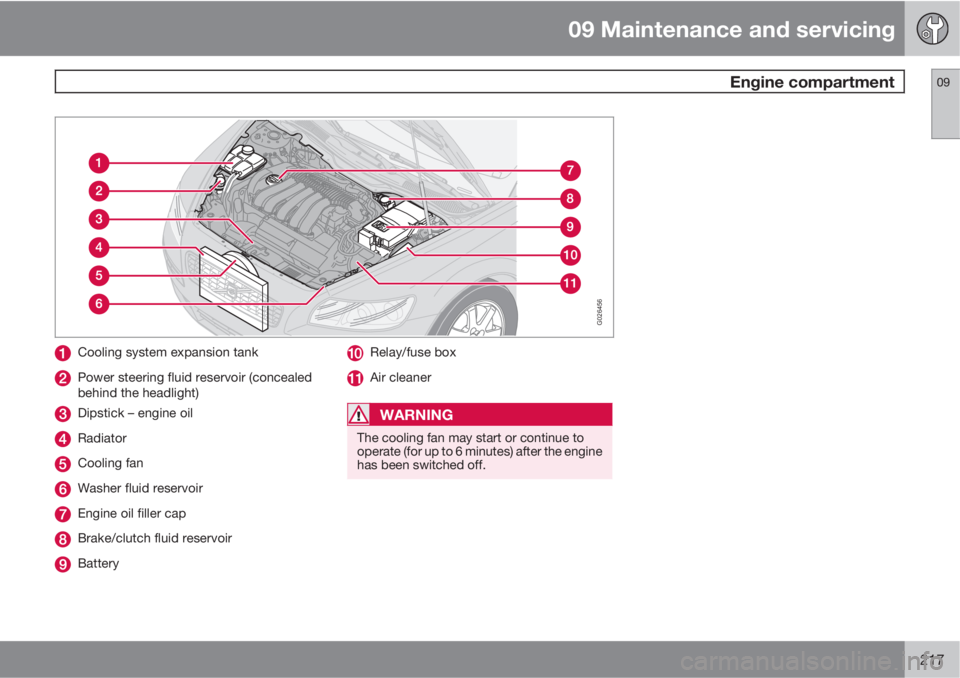
09 Maintenance and servicing
Engine compartment09
217
G026456
Cooling system expansion tank
Power steering fluid reservoir (concealed
behind the headlight)
Dipstick – engine oil
Radiator
Cooling fan
Washer fluid reservoir
Engine oil filler cap
Brake/clutch fluid reservoir
Battery
Relay/fuse box
Air cleaner
WARNING
The cooling fan may start or continue to
operate (for up to 6 minutes) after the engine
has been switched off.
Page 218 of 292
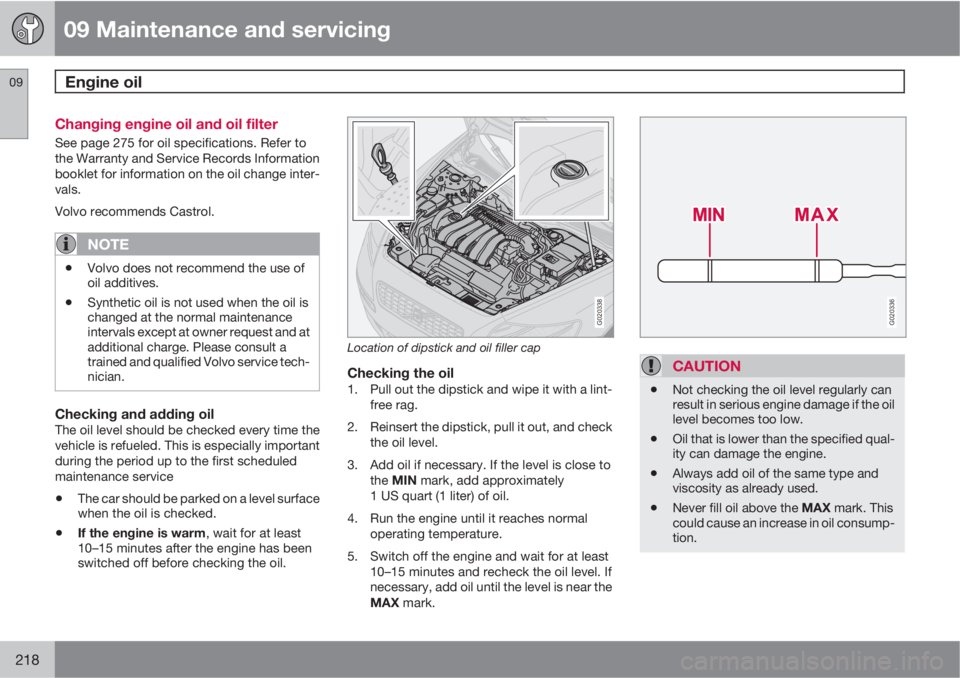
09 Maintenance and servicing
Engine oil 09
218
Changing engine oil and oil filter
See page 275 for oil specifications. Refer to
the Warranty and Service Records Information
booklet for information on the oil change inter-
vals.
Volvo recommends Castrol.
NOTE
•Volvo does not recommend the use of
oil additives.
•Synthetic oil is not used when the oil is
changed at the normal maintenance
intervals except at owner request and at
additional charge. Please consult a
trained and qualified Volvo service tech-
nician.
Checking and adding oilThe oil level should be checked every time the
vehicle is refueled. This is especially important
during the period up to the first scheduled
maintenance service
•The car should be parked on a level surface
when the oil is checked.
•If the engine is warm, wait for at least
10–15 minutes after the engine has been
switched off before checking the oil.
G020338
Location of dipstick and oil filler cap
Checking the oil1. Pull out the dipstick and wipe it with a lint-
free rag.
2. Reinsert the dipstick, pull it out, and check
the oil level.
3. Add oil if necessary. If the level is close to
the MIN mark, add approximately
1 US quart (1 liter) of oil.
4. Run the engine until it reaches normal
operating temperature.
5. Switch off the engine and wait for at least
10–15 minutes and recheck the oil level. If
necessary, add oil until the level is near the
MAX mark.
G020336
CAUTION
•Not checking the oil level regularly can
result in serious engine damage if the oil
level becomes too low.
•Oil that is lower than the specified qual-
ity can damage the engine.
•Always add oil of the same type and
viscosity as already used.
•Never fill oil above the MAX mark. This
could cause an increase in oil consump-
tion.
Page 219 of 292
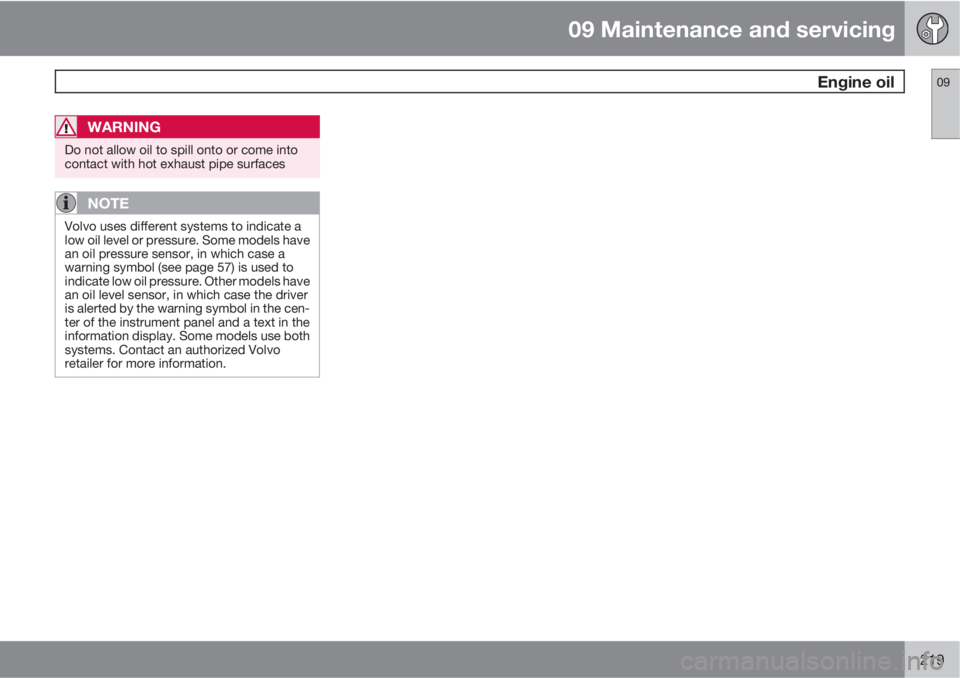
09 Maintenance and servicing
Engine oil09
219
WARNING
Do not allow oil to spill onto or come into
contact with hot exhaust pipe surfaces
NOTE
Volvo uses different systems to indicate a
low oil level or pressure. Some models have
an oil pressure sensor, in which case a
warning symbol (see page 57) is used to
indicate low oil pressure. Other models have
an oil level sensor, in which case the driver
is alerted by the warning symbol in the cen-
ter of the instrument panel and a text in the
information display. Some models use both
systems. Contact an authorized Volvo
retailer for more information.
Page 220 of 292
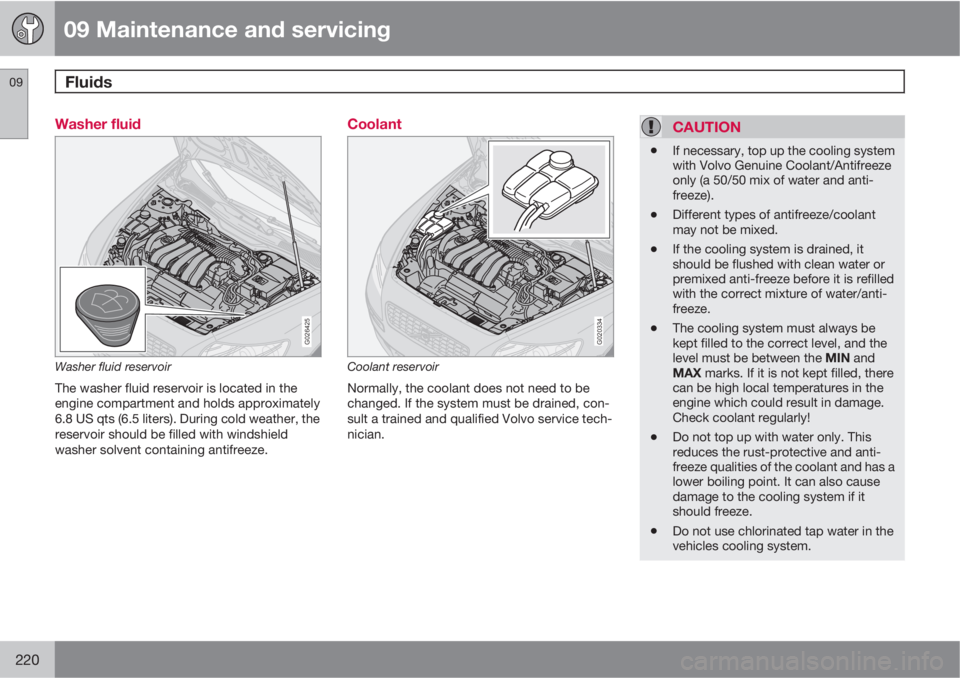
09 Maintenance and servicing
Fluids 09
220
Washer fluid
G026425
Washer fluid reservoir
The washer fluid reservoir is located in the
engine compartment and holds approximately
6.8 US qts (6.5 liters). During cold weather, the
reservoir should be filled with windshield
washer solvent containing antifreeze.
Coolant
G020334
Coolant reservoir
Normally, the coolant does not need to be
changed. If the system must be drained, con-
sult a trained and qualified Volvo service tech-
nician.
CAUTION
•If necessary, top up the cooling system
with Volvo Genuine Coolant/Antifreeze
only (a 50/50 mix of water and anti-
freeze).
•Different types of antifreeze/coolant
may not be mixed.
•If the cooling system is drained, it
should be flushed with clean water or
premixed anti-freeze before it is refilled
with the correct mixture of water/anti-
freeze.
•The cooling system must always be
kept filled to the correct level, and the
level must be between the MIN and
MAX marks. If it is not kept filled, there
can be high local temperatures in the
engine which could result in damage.
Check coolant regularly!
•Do not top up with water only. This
reduces the rust-protective and anti-
freeze qualities of the coolant and has a
lower boiling point. It can also cause
damage to the cooling system if it
should freeze.
•Do not use chlorinated tap water in the
vehicles cooling system.